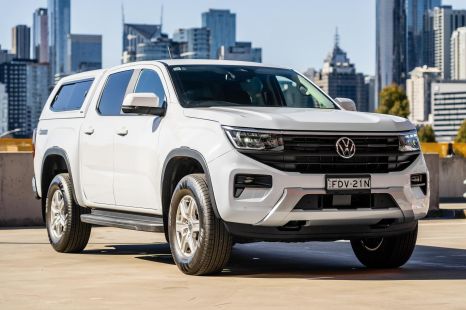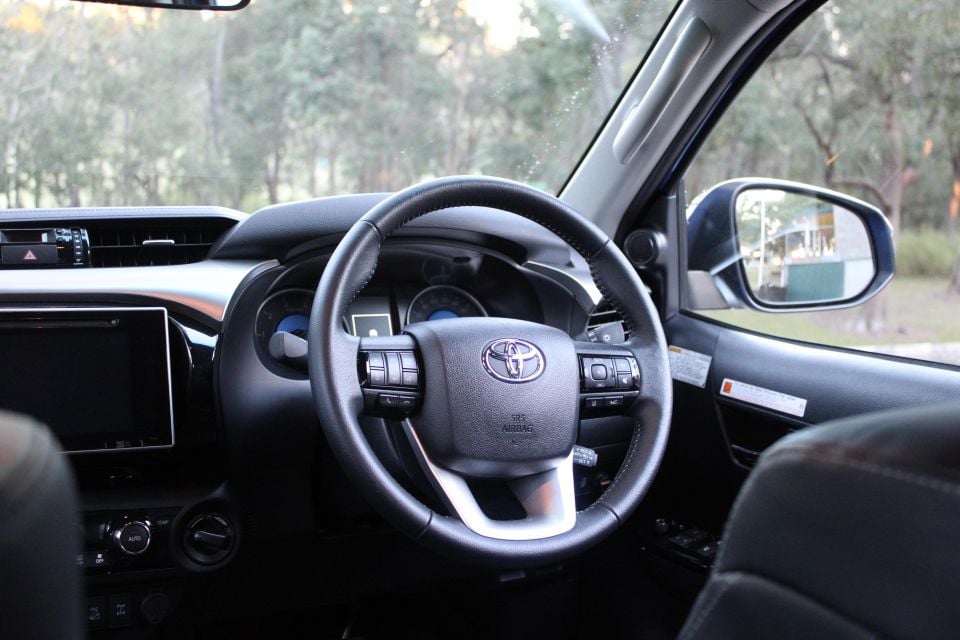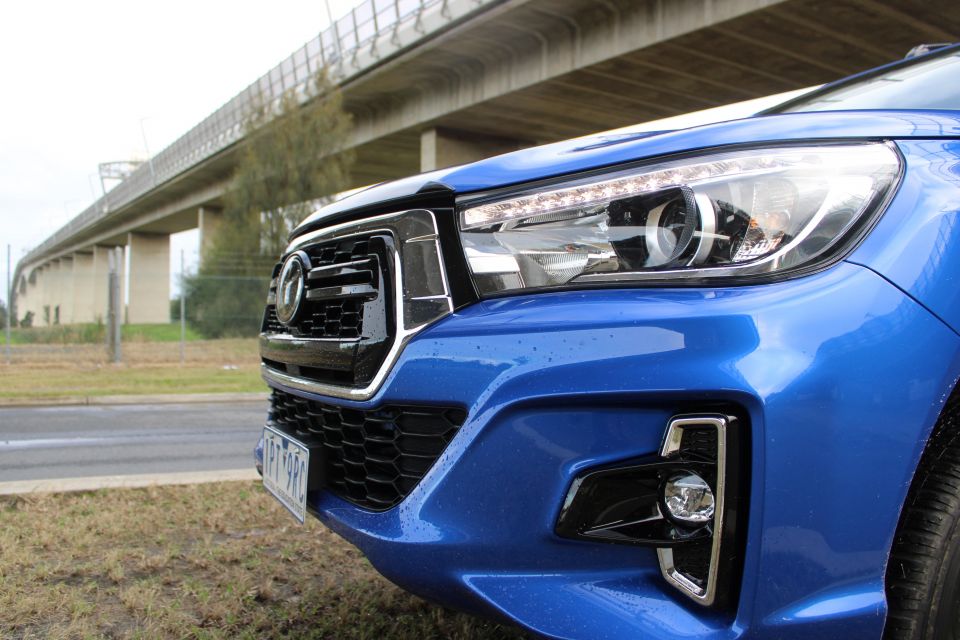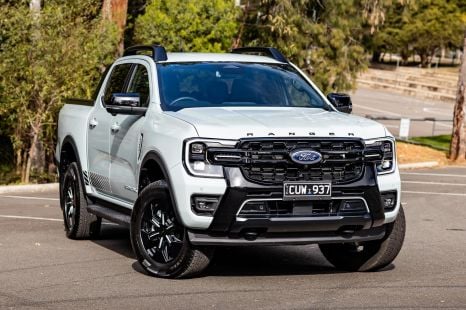

Max Davies
2025 Volkswagen Amarok Life TDI500 review
1 Month Ago
The Toyota HiLux might be the best-selling car in Australia, but it's facing a crop of tough new rivals. With a facelift just weeks away, should you look at the runout car on test here, or wait it out?



News Editor
New from
$22,325
excl. on-roads

News Editor
New from
$22,325
excl. on-roads


News Editor
New from
$22,325
excl. on-roads

News Editor
New from
$22,325
excl. on-roads
Quickly see how this car stacks up against its competition. Select any benchmark to see more details.
Where expert car reviews meet expert car buying – CarExpert gives you trusted advice, personalised service and real savings on your next new car.
Check out our review of the New Toyota Hilux.
The Toyota HiLux is a reliable ute and sensible buy. That’s advice as old as time – you might even find it carved into ancient Mesopotamian tablets.
The HiLux has continued to reign as Australia’s favourite ute (and most popular new vehicle) on the back of its storied reputation, despite fierce competition from the likes of Isuzu, Mitsubishi, Nissan and Volkswagen.
And of course, Ford. While the HiLux continues to dominate the 4×2 ute market, it has faced fierce competition from the Blue Oval brand’s Ranger in the more profitable and sometimes-posher 4×4 segment.
Fittingly, there’s an updated Toyota HiLux coming next month, packing significantly more power and torque, freshened styling and updated infotainment. We’ll review that soon, but here we have a final drive in the outgoing model.


The SR5 dual-cab 4×4 costs $55,240 before on-road costs with a manual transmission and $57,240 before on-road costs with the automatic.
Toyota has regularly advertised drive-away pricing of $54,590 for the automatic, and there might be room to move on that with a new model arriving so soon. Even as COVID-19 looms over us, HiLux sales have been strong, helped in part by the Australian Government’s Instant Asset Write-Off – you can read more about that here and find a list of vehicles eligible for the full write-off amount here.
In terms of its list price, the Toyota HiLux SR5 actually undercuts the equivalent Ranger model. The Ford Ranger XLT dual-cab 4×4 costs $59,040 before on-road costs with the 3.2-litre turbo-diesel and $60,540 with the 2.0-litre twin-turbo diesel.
While the HiLux stacks up well there, the Triton remains the value king – the flagship GLS Premium costs $52,790 before on-road costs. It also adds valuable safety tech like blind-spot monitoring and rear cross-traffic alert that aren’t available on any HiLux.


Adding a ‘5’ to the end of the SR nameplate transforms the HiLux visually. The steel wheels are swapped out for 18-inch alloy wheels, while the halogen headlights are replaced with LED units and accompanied by LED daytime running lights and fog lights. There’s also a stainless steel sport bar.
There’s no in-between model like the Ford Ranger XLS and Mitsubishi Triton GLX+. You either take the work truck SR with its steelies and vinyl floors, or jump up to the SR5. It is a jump, too: comparing dual-cab, automatic, 4×4 models, you’re looking at a premium of $7725 for the SR5.
There’s more than just exterior details to differentiate the two, however. The SR’s 7.0-inch touchscreen infotainment system adds satellite navigation in SR5 trim, while the SR5 also receives push-button start, single-zone climate control and a leatherette-wrapped steering wheel.
Both the SR and SR5 feature telescoping adjustment for the steering wheel, as well as an air-conditioned cooler box and side steps.
Our tester included the $2000 Premium Pack which adds leather upholstery, a power driver’s seat, and heated front seats. It’s also painted in Nebula Blue which, like the other metallic paint options, costs $600.
As on all HiLux models, there’s also adaptive cruise control, proximity entry and automatic headlights. A Ranger XLT packs more convenience features, however, including semi-autonomous parking assist and dual-zone climate control. It also has Android Auto and Apple CarPlay, though this tech will be added to the HiLux when the updated model arrives later this year.

Automakers are belatedly adding active safety technology to their utes. Just last year, autonomous emergency braking (AEB) was rolled out as standard to the entire HiLux range, bringing it in line with the Ranger and Triton.
The inclusion of AEB was enough to maintain a five-star safety rating from ANCAP when it was re-tested last year. It received scores of 96 per cent in adult occupant protection, 87 per cent in child occupant protection, 88 per cent in vulnerable road user protection and 78 per cent in safety assist.
The HiLux’s standard AEB features pedestrian and daytime cyclist detection. Vehicle detection works at speeds between 10 and 180km/h while pedestrians and cyclists are detected at speeds between 10 and 80km/h.
Other standard safety kit includes traffic sign recognition and front, front-side and curtain airbags. There’s also a standard lane departure alert which Toyota describes as “providing steering assistance via the braking system”. Oddly, it seems to work better than the systems we’ve tested in Toyota’s passenger cars.


The Toyota HiLux’s interior mightn’t be ‘high-lux’ but it’s attractive, as ute interiors go. It’s more contemporary inside than the Mazda BT-50 and less unusual than the Isuzu D-Max, though both of these are being replaced this year.
Hard, durable plastics are used throughout the cabin, though the dashboard is spruced up a bit through the use of some silver and piano black trim. The pale blue backlighting is nice and complements the rather striking blue analogue gauges, which are both attractive and legible.


Unfortunately, there’s no digital speedometer on the 4.2-inch information display in the gauge cluster. That’s an inexcusable oversight for Australia’s favourite ute, considering how many speed cameras are out on our roads.
The 7.0-inch touchscreen will be familiar to anybody who’s been in a previous-generation Toyota. It’s relatively intuitive but we wish the menu buttons on either side were actual buttons or at least had haptic feedback.
Annoyingly, when you start up the HiLux and put it in reverse to back out of your space, the reversing camera image takes a good five seconds or so to appear on the screen. That mightn’t seem like much but other cars project the image instantaneously when you put them in reverse. The camera footage is also quite grainy.




The satellite navigation is a bit clunky and isn’t as intuitive as Google Maps. Unfortunately, Google Maps is off-limits as the HiLux lacks Android Auto and Apple CarPlay. The updated model will receive these along with a larger, 8.0-inch screen. Unfortunately, it looks like some other interior issues will go unaddressed. These include a cheap-feeling gated shifter, a chintzy handbrake and a leatherette-wrapped steering wheel that feels more like urethane than leather.
The position of the cupholders at the base of the centre stack means large bottles can block some of the switches, though your front-seat passenger can use a clever, pull-out cupholder by their air vent. The very bottom of the centre stack is also hard to see at night – brighter backlighting would be a good idea for the heated seat controls, for example. By the way, those heated seats are one-stage only, meaning you’ll probably burn your butt and turn them off quite quickly. At least the seats themselves are quite comfortable.
To the right of the steering wheel you’ll find the switch for the manual regeneration of the diesel particulate filtration (DPF) system. A large warning sticker on the driver’s door warns you to pull over if the DPF light comes on.
I’ve seen some young tradies put even more care in their appearance than I do so the absence of a vanity mirror for the driver’s sun visor is baffling. At least young tradies will appreciate the six-speaker sound system, which has surprisingly good sound quality for an unbranded unit.
Cabin storage is ample. Highlights include the two glove compartments and bottle holders in the doors that actually fit large bottles.



The back seat has plenty of room for adult occupants. Grab handles on the B-pillars help you get up and once you’re settled into the comfortable bench, you’ll find rear air-conditioning vents and soft, upholstered seat backs with pockets. There are two top-tether and two ISOFIX child seat anchor points back there.
There aren’t any USB or charging outlets in the back, though there’s a USB outlet and two 12V outlets up front.
The tub measures 1569mm long, 481mm deep, and 1645mm wide, narrowing to 1109mm between the wheel arches. That’s fractionally longer than the Ranger’s but 30mm shallower. The HiLux also lacks a power outlet back there, though you’ll find one in the Ford.


Gone is the once ubiquitous petrol V6 HiLux. That leaves a range of three four-cylinder engines – a 2.7-litre petrol, a 2.4-litre turbo-diesel, and the 2.8-litre turbo-diesel seen here. The first two are available only on the base WorkMate, leaving the larger diesel as the sole powerplant for the rest of the range including the featured SR5.
The 2.8-litre produces 130kW of power and either 420Nm or 450Nm of torque, depending on whether it’s mated to a six-speed manual or six-speed automatic transmission, respectively.
The updated model sees a significant jump in outputs to 150kW of power and 500Nm of torque, just 7kW off from the twin-turbo diesel in up-spec Rangers. It’s a worthy upgrade considering this current up-spec HiLux engine produces less power and torque than the mid-range 3.2-litre turbo-diesel five-cylinder in the Ranger.

The leaf-sprung rear end results in a rather jiggly ride for the HiLux while unladen, though it feels slightly less skittish than a Triton. The bounciness settles down at higher speeds, with the HiLux delivering a fairly comfortable highway ride.
On the highway, the HiLux chugs along at 1500rpm in sixth and it’s relatively quiet, with just the muted clatter of the engine and some wind whistling around the mirrors. Around town you’ll hear the trademark turbo-diesel clatter but it isn’t obnoxious.


The 2.8-litre turbo-diesel is no rocketship but there’s enough grunt, aided by a well-calibrated six-speed automatic transmission. A ‘Power’ button near the shifter sharpens the throttle response.
The hydraulically-assisted steering can feel a touch vague but, overall, the HiLux doesn’t feel overly agricultural. You won’t mistake it for a car, though.
Off the beaten path, you can choose between low- and high-range four-wheel drive modes and you can lock the rear differential. There’s no full-time four-wheel drive mode you can use on the road, however, like you’ll find in Tritons GLS and up.


The HiLux has superior approach and departure angles to its rivals, at 31 and 26 degrees respectively. The Ranger XLT’s are 29 and 21 degrees and the Triton GLS Premium’s are 27.5 and 23 degrees.
The Ranger has the edge in terms of payload and braked towing capacity, however. The HiLux SR5 has a payload of 955kg and a braked towing capacity of 3200kg, while the Ranger XLT hauls a payload of 970-991kg depending on the engine and has a braked towing capacity of 3500kg. Other rivals like the Nissan Navara and Isuzu D-Max also have a 3500kg braked towing capacity.
Over a mix of city and highway driving, we averaged 10.0L/100km. Toyota claims a fuel economy figure of 8.4L/100km on the ADR combined cycle.
As is unfortunately common with Toyotas, the HiLux has frustratingly short service intervals – six months or 10,000km, whichever comes first. The first four services are capped at $250.
By comparison, a Ford Ranger has 12 month/15,000km intervals and has its first four services capped at $299 while the Mitsubishi Triton has the same intervals and the same service price, albeit only for the first three visits. With the Toyota, therefore, you’ll be at your dealer more often and spending more per service.


Toyota isn’t just resting on its laurels. The HiLux remains a solid choice in its segment thanks to its comfortable interior and decent on-road manners.
You’ll find more active safety tech than a Nissan Navara or Volkswagen Amarok and slightly better on-road manners than a Mitsubishi Triton. That pesky Triton, however, offers remarkable value for money.
The upcoming, third-generation Isuzu D-Max and Mazda BT-50 also make a compelling case for looking outside of the Toyota showroom.
While the HiLux’s turbo-diesel is outpunched by rivals like the Ford Ranger, the updated and much gruntier HiLux is just months away from reaching Aussie showrooms. The extra power and tech will be most welcome but if you can get a good deal on the current model, we don’t think you’ll regret it.
Where expert car reviews meet expert car buying – CarExpert gives you trusted advice, personalised service and real savings on your next new car.
Discover and compare similar models
William Stopford is an automotive journalist based in Brisbane, Australia. William is a Business/Journalism graduate from the Queensland University of Technology who loves to travel, briefly lived in the US, and has a particular interest in the American car industry.


Max Davies
1 Month Ago


Matt Campbell
22 Days Ago


Damion Smy
15 Days Ago


Josh Nevett
13 Days Ago


Damion Smy
13 Days Ago


William Stopford
13 Days Ago
Suggested Comparisons